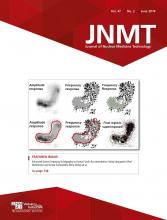Abstract
A gratifying clinical response obtained in the setting of bilateral orbital metastases from renal neuroendocrine tumor is reported. Methods: A 53-y-old man diagnosed with renal neuroendocrine tumor (MIB1 index, 4%), with symptoms of skeletal and abdominal pain, proptosis, and a decrease in vision of the left eye, was found to harbor bilateral orbital soft-tissue lesions on 68Ga-DOTATATE PET/CT and MRI in addition to widespread metastatic skeletal lesions and metastatic lymph nodal disease. Despite radiotherapy to the left eye (20 Gy) and long-acting octreotide therapy for 18 mo, his symptoms worsened, with an increase in serum chromogranin A level, and he was considered for 177Lu-DOTATATE peptide receptor radionuclide therapy (PRRT). Results: There was a significant improvement in skeletal pain, proptosis, and vision after 4 cycles of PRRT (cumulative dose of 22.2 GBq), stable disease on scanning, and a decrease in serum chromogranin A (from 150 to 36.39 ng/mL), with progression-free survival at 18 mo. Conclusion: PRRT through theranostic application of 68Ga/177Lu-DOTATATE was thus helpful in this uncommon clinical setting.
Neuroendocrine tumors (NETs) are a heterogeneous group of neoplasms with differing biologic behavior and response to treatment. Neuroendocrine cells are usually not found within normal renal parenchyma, resulting in a relatively rare incidence of primary renal NET, with a debatable pathogenesis. Different theories have been put forth to support the origin: primitive totipotential stem cells that subsequently differentiate in a neuroendocrine direction, metastasis from an occult primary tumor site to the kidney, or activation of aberrant gene sequences in a totipotential stem cell line that differentiates into aberrant NET cells (1,2).
CASE REPORT
A 53-y-old man diagnosed with renal NET (MIB1 index, 4%) presented with skeletal pain all over the body, abdominal pain, proptosis, and a decrease in the vision of the left eye, 1 y after right nephrectomy. The imaging findings are shown in Figure 1. 68Ga-DOTATATE PET/CT demonstrated enhanced tracer uptake in widespread metastatic skeletal lesions; cervical, mediastinal, and abdominopelvic metastatic lymph nodal disease; and bilateral orbital soft-tissue lesions. MRI of the head showed oval to rounded T2-hyperintense and T1-hypointense lesions with moderate homogeneous enhancement involving the left lateral rectus, left inferior oblique, right lateral rectus, and right inferior oblique muscles in an intraconal location, with compression of the left optic nerve. He received local radiotherapy to the left eye (20 Gy) and systemic octreotide (for 18 mo); however, the symptoms worsened even on these therapies, and there was an increase in the serum chromogranin A level. Thus, he was considered for 177Lu-DOTATATE peptide receptor radionuclide therapy (PRRT) in view of high uptake on 68Ga-DOTATATE PET/CT. There was significant improvement in skeletal pain, proptosis, and vision (resulting in a better quality of life) after 4 cycles of PRRT with a cumulative dose of 22.2 GBq, stabilization of disease on scanning, and a decrease in the serum chromogranin A level (from 150 to 36.39 ng/mL), with progression-free survival at 18 mo.
(A) 68Ga-DOTATATE PET/CT showing increased tracer uptake in widespread metastatic skeletal lesions; in cervical, mediastinal, abdominopelvic lymph nodes; and bilaterally in orbital soft-tissue lesions. (B) MRI of head showing oval to rounded T2-hyperintense and T1-hypointense lesions with moderate homogeneous enhancement involving left lateral rectus, left inferior oblique, right lateral rectus, and right inferior oblique muscles in intraconal locations with compression of left optic nerve, along with abnormal tracer uptake on fused PET/MRI. (C) Scan at 24 h after PRRT demonstrating adequate tracer uptake in multiple metastatic lesions.
DISCUSSION
The clinical course of renal NET is unpredictable: largely believed to have an indolent course (well-differentiated type), its current recommended management includes radical nephrectomy with surveillance. For any metastatic disease, medical management with or without a surgical approach is considered (1). Because of its asymptomatic nature, renal NET can present with metastatic disease (∼45.6% of reported cases), the common sites being lymph nodes and liver (2).
Orbital metastases from NET are rare and typically occur through hematogenous spread by the carotid and ophthalmic arteries. The management options include excision, orbital exenteration, radiotherapy, hormonal therapy, and chemotherapy. However, there is no definitive consensus approach on management, with a loss of vision after exenteration, a high chance of recurrence after surgical excision, and a mixed response after radiotherapy (3). The overall reported survival for metastatic orbital NET is 72% at 5 y and 38% at 10 y (4); preserving vision and maintaining a good quality of life are fundamentally important in the management of these patients. In such cases, PRRT is a potential treatment option for disseminated lesions, is well tolerated and safe, and can be effective, resulting in improvement of vision along with a better quality of life.
CONCLUSION
PRRT through theranostic application of 68Ga/177Lu-DOTATATE was helpful in this uncommon clinical setting.
DISCLOSURE
No potential conflict of interest relevant to this article was reported.
Footnotes
Published online Aug. 23, 2018.
- Received for publication July 9, 2018.
- Accepted for publication August 9, 2018.








